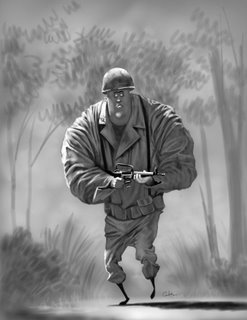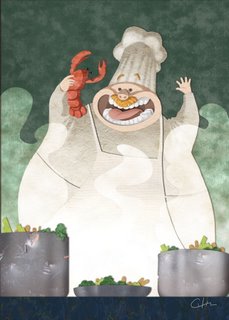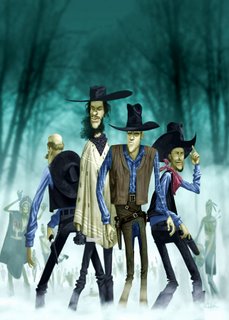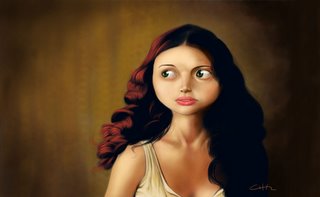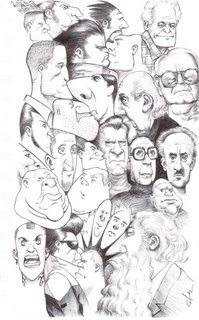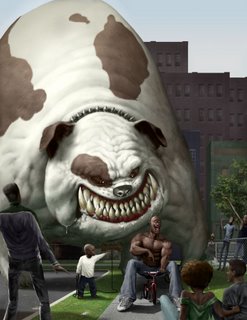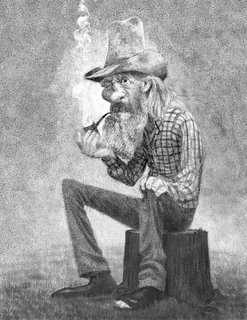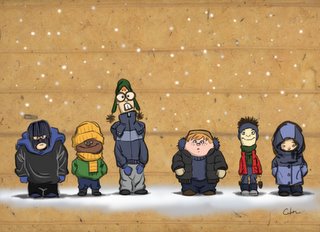BOBBY CHIU INTERVIEW
Character Designer
Tuesday, February 14, 2006
BROUGHT TO YOU BY THE CHARACTER DESIGN BLOGSPOT
IF YOU WOULD LIKE TO SEE MORE CHARACTER DESIGNERS GO TO THE HOME PAGE BY CLICKING HERE
THE INTERVIEW
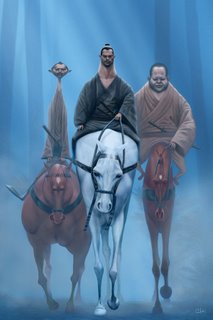
Tell me a little bit about yourself, about your life? Where did you go to school, and what classes did you study? What helped prepare you to become the artist that you are today?
I'm an independent artist from Toronto, Canada. I started my career at a company called Thinkway Toys when I was 17 years old, designing Disney, Pixar and Star Wars toys. With regards to schooling, I studied classical and computer animation at Sheridan College. However, I wanted to learn as much as I could about art so I did a lot of other things in addition to that, from painting to Chinese watercolor. And of course I sketched and drew all the time.
Throughout my art career, I’ve had a deep interest in illustration and character design. Now I make art books and teach digital painting at Sheridan College. Art has given me freedom. Half the time I feel like I've already retired. I sleep when I want, I get up when I want. It’s amazing how hard you can “work” when you do what you love and love what you do. It’s a cliché, but I’m constantly amazed that I can make a living simply doing what I love all day: art. What could be better than that?
I believe, if it weren’t for my passion and consistency, I wouldn’t be where I am today. I’m passionate about every piece of work I’ve ever put my name on. Some people say you can’t be too attached to your work because it could go through changes and revisions. I don’t entirely agree. Passion is what makes an artist draw at his/her top potential. If you’re so detached that you can give up your work without feeling anything, then I think that shows your learning potential has about peaked. I mean, changes to my work is inevitable, but that doesn’t mean I have to like it. It hurts when I have to change something that I was passionate about, but this pain ensures that I will be passionate about my revision too. As an individual, I will not settle for anything less than that.
Consistency and diligence is also extremely important. When we get too comfortable with our skill level, we tend to get complacent—we just tend to try and maintain. This is not enough. In my second book, “Cats & Dogs Sketches”, I talk about learning art faster by consistently doing exercises to improve a certain way of thinking. In my next book, “Guy Sketches”, I share my two-hour “drawing workout”, which I do at least three times a week to help improve my art skills.
And finally, I have “Bobby Chiu’s Subway Sketch Group” here in Toronto every Sunday. This is where a group of us ride the train back and forth for a few hours, sketching random people. It’s a great art exercise and a lot of fun!
How do you go about designing a character, and what goes through your mind, from start to end?
A lot of people forget that, when you’re designing a character, it’s not just a matter of doodling a picture in a notebook. A CHARACTER and a PICTURE are two completely different things: a picture can be a stand-alone image that exists for its own sake. Characters do not have this luxury; characters have certain responsibilities to fulfill, they must bring across a very distinct purpose.
So, when I set out to design a character, the first thing I consider is, what is the purpose of the character? Is it humorous? Cool? Scary? Then I ask myself, who’s our target audience? What’s the story behind the character? Before you even start committing lines to paper, you must have a clear idea of the direction you want to take the character in, and you must keep this in the front of your mind at all times so that your character will be designed with focus and purpose. If you lose track of what you’re trying to accomplish with your character, you’re liable to go off on all kinds of tangents and adding a ton of extraneous details that seemed like a good idea at the time, but will make a big mess of the final design. Think of it this way: how enjoyable would you find a movie that’s a romance-action-comedy-sci-fi-drama-horror-thriller? Probably not very, because you will be so confused about what kind of reaction the film was trying to get out of you. Same thing with characters. So try to maintain a clearly focused vision.
Once I know for certain what purpose my character is meant to serve, I start drawing out shapes while imagining what the final character might look like. It’s very important to brainstorm a ton of details at this stage.
What kind of skin does it have? Smooth? Fur? Maybe scales?
What kind of fingernails does the character have? Are the dirty? Cracked? Are they talons?
Does the character wear clothes? And if so, what kind?
What kind of treatment will I eventually put on it? How am I going to paint it? Smooth, painterly, chalky, or something else? Any better, more innovative ideas I can try? Think details, details, details!
After I have a nice sketch worked out, if it’s a more complex character, I might do a quick tonal sketch to work out all the lighting issues. Then I begin painting, keeping in mind that tones and color also contribute a great deal to the overall effect of the character. Take Batman, for example: it’s not an accident that Batman is covered in black and gray armor with shadows all over the place. This brings across the overall effect of Batman as a vigilante—the Dark Knight. This also goes back to what I was saying about maintaining focus.
I have a bunch of different ways to add color but lately I’ve been fond of the more common layering technique where you keep adding layers on top of layers of colors until the job is done.
What do you think really helps you out in designing a character?
Subway sketching has been a great exercise but doing my “drawing workout” 3 times a week consistently has been the key to my success.
From your own experience and maybe from some people that you know, what should we put in our portfolio and what should we not?
Put your best piece first and your second best piece last and your third best in the middle. I find that this is the best way to show the client that you have a consistent skill level.
Also, avoid the temptation of putting in too much. This way, you will always have some back-up pieces that you can bring in to the interview if they call you in.
What are some of the things that you have worked on?
I started out in toy design (Disney, Star Wars, Pixar toys). I’ve also done freelance projects for many different companies including painting the box cover for Alias Sketchbook Pro 2.
Most of what I do now is independent. Every three months, I publish an art book on a specific topic. For example, in my “Girl Sketches” book, there are big girls, skinny girls, old women, witches, cave women, etc. They’re done in a variety of different styles, with guest artists as well as my own work. There are also tips and articles on how I draw and think and learn art. These books are excellent for an artist’s reference library.
Is there a character design you have done that you are most proud of?
I’m working on a comic book right now that will use a new style that I’ve been developing. I love the characters in it because I don’t think they fit any kind of mold. They’re very much a fusion of different traditions, very urban and very fresh.
What are you working on now? (If you can tell us)
I’m working with Kei Acedera and Nelvana on our own TV show.
In addition, I’m preparing to launch my next book, “Guy Sketches”, at the New York Comic-Con February 24 to 26. It’s looking fantastic! I’m very proud of it. There are fighters, mafia guys, soldiers, samurais, old guys, nerds, hip hop characters, rockers, punks, hairy guys, bald guys, and tons and tons of other stuff. And as always, I will be joined by some fantastic guest artists such as Robin Mitchell, Kei Acedera, Jim Bryson, Matt Lyons, Charles Guan and an exciting new artist, Shaz Lym.
Where is the place you would like to work if you had a choice?
I run my own art studio in Toronto with full creative control over my work. I can’t imagine feeling as fulfilled and as free working anywhere else!
Who do you think are the top character designers out there?
Some of the designers I really admire are Nicolas Marlet, Stephen Silver, Dean Yeagle, Peter DeSeve, and Ragnar. I'm constantly awed by the quality of their work.
How do you go about coloring the character, what type of tools or media do you use?
When I’m out and about just sketching, I prefer to use a normal black ballpoint pen. On the computer, my preferred painting programs are Alias Sketchbook Pro, Adobe Photoshop, and Painter. My tablet is a Wacom Cintiq 18SX.
I employ numerous techniques when it comes to coloring a painting. I don’t really like to stick with one style for too long because I fear stagnation so much. I’m constantly experimenting with combining styles, trying to apply a certain style that I’d just been exposed to, or picking up a style that I haven’t used for a while. I like to keep myself on my toes.
What part of designing a character is most fun and easy, and what is most hard?
I think the first stage of development is the easiest and most fun because I’m just generating ideas and brainstorming; I don’t need to worry about rules or structure or anything at this point. In contrast, the final polish is the… well, I wouldn’t say that it’s the LEAST fun, but it’s definitely the most serious stage because there are a lot of fine issues to get just right. This stage is the most taxing on my technical skills and therefore I would consider this part the most difficult and sometimes even frustrating.
What are some of your favorite character designs and least favorite, which you have seen?
I love the character design for Dean Yeagle’s Mandy. Dean captures a kind of joy in her that few other characters I've seen are able to communicate.
What is your most favorite subject to draw? And why?
I like drawing all sorts of things, as long as they're interesting. However, if I had to pick an absolute favorite subject, I think it’d have to be old people. I love drawing old folks because their wrinkles always seem to tell a story of who they are and where they’ve been.
What inspired you to become a Character Designer?
I love telling stories through character. Character design isn’t just about who can draw better or capture the most anatomically accurate figure; it’s about capturing all the nuances that comes with having a vibrant personality and living a full life (even if that personality and life are just figments of my imagination). For me, this is the whole package that I, as an artist, try to capture, so I suppose it’s natural that I gravitated towards character design.
What are some of the neat things you have learned from other artists that you have worked with or seen?
I’ve seen many great artists draw and I’ve learned a lot from them too but it’s kind of hard to explain. What I’ve found is that, creative people, whether they’re artists or writers or musicians or whatever, they all go about the business of creation in different ways. From one person, I might learn to draw dark shadows on a white canvas. From another, I might learn to draw bright light on a black canvas. The more I try to become a student of the world around me, the more I’d pick up in terms of visual cues to represent certain characteristics and processes to draw and design characters more effectively.
What wisdom could you give us, about being a character designer? Do you have any tips you could give?
Three things:
1) The best artists and character designers are forever tinkering and fidgeting with their work because they’re just never satisfied. Always expecting more of yourself is the best way to elevate your skills to the next level.
2) Never take any jobs that you don’t like. If you don’t like a job, you can’t feel passion for it. If you can’t feel passion, you won’t be able to bring out your best work. And if you can’t bring out your best work, well, what would be the point? Why even get out of bed then?
And finally, 3) Draw and paint everyday. You’re an artist and a character designer. You should WANT to draw and paint everyday. You’d think that this goes without saying, but it’s amazing how many talented people can’t put in the effort to do what they already do better than 98% of the rest of the human population and as a result they fall by the wayside.
If people would like to contact you, how would you like to be contacted?
I can be reached at bobbychiu@imaginismstudios.com.
My website is http://www.imaginismstudios.com.
Finally, do you have any of your art work for sale (sketchbook, prints, or anything) for people that like your work can know where and when to buy it?
Sure! You can buy my books – “Girl Sketches”, “Cats & Dogs Sketches”, and pre-order “Guy Sketches” at http://www.imaginismstudios.com/books.html
I also sell my prints at http://www.imaginismstudios.com/prints.html
If you live in the Greater Toronto Area, you can sign up for my summer class at the Sheridan College Registrar’s Office or at
http://sculptor.sheridanc.on.ca/webapp/wcs/stores/servlet/ProductDisplay?catalogId=10101&storeId=10051&productId=53211&langId=-1
You can also find his Books at SketchMart Here http://sketchmart-sketchbooks.blogspot.com/
Subscribe to:
Posts (Atom)
